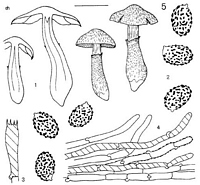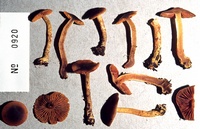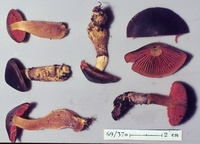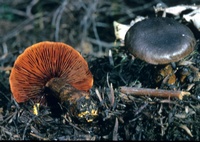|
 Cortinarius persplendidus Cortinarius persplendidus
SynonymsDermocybe splendida
BiostatusPresent in region - Indigenous. Non endemic
Images (click to enlarge)
Caption: Dermocybe splendida: 1. carpophores. - 2. spores. - 3. basidium. - 4. pileipellis. | 
Caption: ZT0920
Owner: E. Horak: © Creative Commons Attribution-Noncommercial 3.0 New Zealand | 
Caption: ZT69-370 , Holotype
Owner: E. Horak: © Creative Commons Attribution-Noncommercial 3.0 New Zealand | 
Caption: ZT69-370 , Holotype
Owner: E. Horak: © Creative Commons Attribution-Noncommercial 3.0 New Zealand | |
Article: Horak, E. (1988) [1987]. New species of Dermocybe (Agaricales) from New Zealand. Sydowia 40: 81-112.
Description: Pileus - 5 mm, hemispherical, convex to broadly umbonate or obtusely campanulate; centre black, black-brown or dark brown, yellow-orange near margin in mature specimens; dry, radially fibrillose or minutely squamulose, neither hygrophanous nor margin striated, margin often splitting, persistent veil remnants none. - Lamellae 16-28, 3(-5), adnexed to emarginate becoming sinuate with short decurrent tooth in aged carpophores, -5 mm wide; brilliant orange, cinnabar red-orange, brick red turning bright orange-ferruginous, edges concolorous, entire. Stipe -60 x 3-8 mm, clavate, subbulbous or fusoid (-13 mm diam.), rarely cylindrical, single; golden yellow or brass yellow, at base with yellow tomentum or yellow rhizoids, persistent dark brown or black cortina fibrillose or occasionally agglutinated and submembranaceous, below ring coarsely fibrillose or covered with minute concolorous squamules; dry, solid becoming hollow. - Context dark brown in pileus, yellow-orange in stipe. - Odour and taste not distinctive.
Chemical reactions on pileus: KOH - red-brown; on lamellae: KOH - lilac-blue.
Spore print rust brown. - Spores 7-9 x 5-6.5 µm, broadly ovoid (or subglobose), covered with conspicuous isolated warts which can be connected to short crests, rust brown, plage or perispore absent. - Basidia 36-34 x 6-9 µm, 4-spored, often with brilliant purple plasmatic pigment. - Cheilocystidia absent. - Pileipellis a cutis or trichoderm composed of cylindrical hyphae (5-10 µm diam.), terminal cells cylindrical or subconical, membranes not gelatinized, with dark brown plasmatic (rarely also encrusting) pigment readily dissolving in KOH and staining solvent brilliant wine red or bright purple. - Clamp connections present.
Habitat: On soil under Leptospermum spp. - New Zealand, Australia.
Notes: The description of D. splendida is based upon four collections from New Zealand. The present distribution area indicates that this species is strictly associated with the two native taxa of Leptospermum (L. scoparium, L. ericoides) in the subtropical northern parts of North Island. D. splendida is also reported from Australia. The Western Australian (HORAK, 1983) and the Victorian (GILL, unpubl.) specimens examined were gathered in broadleaved forests dominated by several species of Eucalyptus. Nevertheless this material agreed in all essential morphological characters and pigment pattern with the New Zealand specimens (KELLER & al., 1988). Regarding the qualitative composition of the anthraquinoid derivatives in D. splendida the simultaneous occurrence of xanthopurpurin, austrocortilutein and austrocortirubin is unique among the austral-asian representatives of Dermocybe. A similar pigmentation pattern (GILL & STEGLICH, 1987) is only known from another, taxonomically yet doubtful (MOSER & HORAK, 1975) Australian taxon viz. Cortinarius (Dermocybe) umbonatus CLELAND & HARRIS (1948).
|